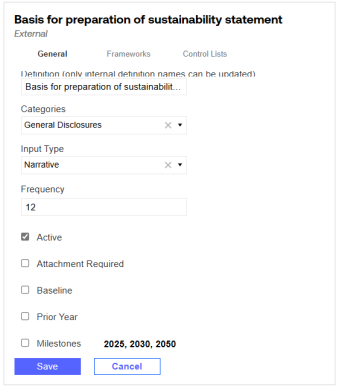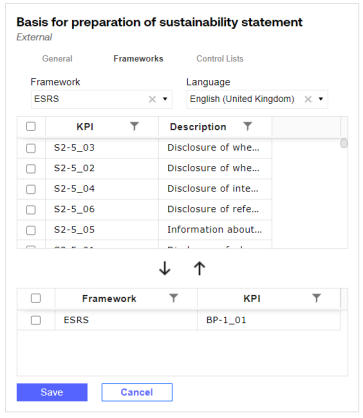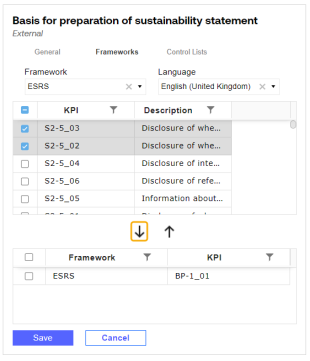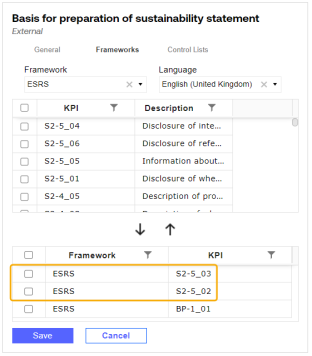To view definition details, select a definition from the Definitions grid and the Definitions details pane is displayed. Use the Definitions details pane to edit the selected definition. The Definitions details pane has three tabs: General, Frameworks, and Control Lists.

General
Use the General tab to edit definition general properties.
| Property | Definition |
|---|---|
| Definition | The Definition field is read only. System defined definitions cannot be edited. |
| Categories |
To change a definition's category, use the Categories drop-down menu. |
| Input Type | To change a definition's input type, use the Input Type drop-down menu. To view which input types are mapped to the ESRS data types, see Definition Input Types. |
| Frequency |
To edit a definition's frequency, use the Frequency field. Comma delimited format and range format is accepted in this field. This frequency determines which workflow periods the definition will display in. Definitions with a Narrative unit type default to a yearly frequency. |
| Active | Definitions are active by default. To make a definition inactive, clear the Active checkbox. |
| Attachment Required | To require an attachment for a definition, select the Attachment Required checkbox. |
| Baseline | To include the baseline year in the report for this definition, select the Baseline checkbox. The values set up in the Global Options page display here. See Global Options. |
| Prior Year | To include the prior year in the report for this definition, select the Prior Year checkbox. |
| Milestones | To include the milestone years in the report for this definition, select the Milestones checkbox. The values set up in the Global Options page display here. See Global Options. |
See Report Structure and Data Management for details on how the Baseline, Prior Year, and Milestone options impact data collection and reporting.
NOTE: The Baseline, Prior Year, and Milestone checkboxes are selected by default for definitions linked to KPIs E1-6: 
Click the Save button after editing general definition properties.
Frameworks
Use the Frameworks tab to view which framework KPI is assigned to the definition. The assigned framework KPI is displayed in the bottom grid. For more information on frameworks, see Frameworks.

To assign additional framework KPIs to the definition, complete the following steps:
-
From the Frameworks drop-down menu, select the framework containing the KPIs you want to assign to the definition. All KPIs in that framework display in the grid below.
NOTE: Both internal and external frameworks are supported and will display in the Frameworks drop-down menu.
-
Use the checkboxs to select KPIs.
-
Click the Add button. The KPIs display in the bottom grid.


-
Click the Save button.
To remove a KPI from a definition, select the KPI from the bottom grid and click the Remove button. Click the Save button.
Control Lists
Use the Control Lists tab to assign control lists to the selected definition. No more than two control lists can be assigned to a definition. For more information on control lists, see Control Lists.
To assign control lists to a definition, from the Control List 1 and Control List 2 drop-down menus, select control lists and then click the Save button. The Control List 1 selection cannot be None if Control List 2 has a selection. The selection for Control List 1 displays as the first column on the report, and the selection for Control List 2 displays as the second column. See Narrative Control List Table Display.





